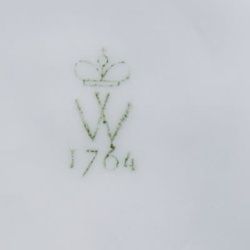
Wallendorfer Porzellan или Wallendorf фарфор - это компания по производству фарфора, которая работает с 1764 года в Лихте (Валлендорф) в тюрингском нагорье Wallendorf является одной из марок фарфора в Германии и во всей Европе.
В 18 веке территория Лихте (Валлендорф) была расположена в двух разных княжествах с рекой Лихте, образующей границу. На Западном берегу находился Шварцбург-Рудольштадт, а на восточном-Саксен-Кобург-Заальфельд .
В 1761 году, почти через 50 лет после изобретения фарфорового производства Эренфридом Вальтером фон Чирнхаусом и Иоганном Фридрихом Беттгером , Йохан Вольфганг Гамман из Катцхютте подал заявку в дом Шарцбург-Рудольштадт на концессию фарфорового производства. К сожалению , всего три дня назад эта концессия была предоставлена Генриху Махелейду в Ситцендорфе, поэтому просьба Хаммана была отклонена. Однако он не отказался от своей мечты. Через год он уже мог обжигать твердый фарфор в Кацхютте, а еще через год приобрел усадьбу барона Гогенталя в Лихте на берегу реки Сакс-Кобург-Заальфельд.
Наконец, герцог Саксен-Кобургский предоставил Гамману свою концессию на производство фарфора, и в 1764 году вместе с Готтхельфом Грейнером и его двоюродным братом Готфридом Грейнером он основал компанию по производству фарфора в Лихте (Валлендорф). В результате была создана торговая марка Wallendorf porcelain , одна из старейших фарфоровых торговых марок в Европе.

Первоначально валлендорфский фарфор изготавливался с использованием местного сырья. Это была главная причина для нечистого и тонированного фарфора. Однако к 1780 году чешский каолин уже использовался, в результате чего получился белоснежный твердый фарфор. По словам эксперта Вильгельма Марциуса в 1793 году, "валлендорфский фарфор теперь блестяще белый,. . . красиво "окрашенные и настолько твердые, что даже искры выбрасываются трением о сталь".
До 1833 года компания оставалась в руках семьи Хамманна. Последовавшие за этим бурные годы характеризовались частыми сменами собственников. Среди известных имен-указаний на традиции фарфора и качество даже сегодня-можно найти Hutschenreuther , Kämpfe, Sonntag, Heubach, Fraureuth и Schaubach. Изменения в собственности и экономические взлеты и падения были отражены в изменениях внутридемарков. В этот раз имитация мейсенского фарфора товарные знаки были замечены и стали предметом жалоб в избирательную Саксен-Кобургскую земельную администрацию. Сегодняшняя торговая марка буквы W под короной и годом основания 1764 года была введена через 200 лет после основания валлендорфского фарфора.
Типичный характер валлендорфского фарфора сохранился на протяжении почти двух с половиной столетий до наших дней. В 1764 году началось производство кофе, чая и шоколада ручной работы, а в 1785 году они были дополнены статуэтками. Эти направления по-прежнему являются основными направлениями производства. Конечно, изменилась технология приготовления сырьевых смесей и процедуры обжига. Тем не менее, особая детальная композиция, изобретенная Хамманом, была улучшена и пережила века как совершенно секретная, доступная только для инсайдеров. Типичные процедуры ручной работы, такие как управление качеством специалистами и ручная роспись, остались практически неизменными.








